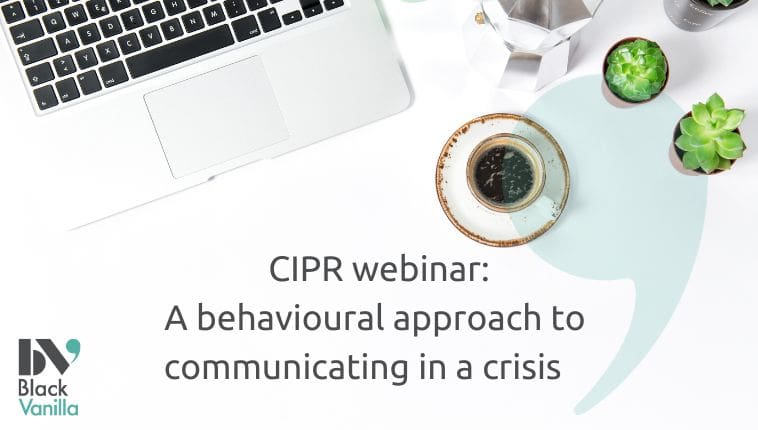
CIPR webinar – a behavioural approach to communicating in a crisis
Nichole Culverwell tuned into the CIPR’s latest crisis communications webinar. As always, the session was excellent, with Abigail Emery, Head of Behavioural Science Cabinet Office, and Eleanor Prince, Senior Behavioural Scientist Cabinet Office. Here’s what she learnt:
In a crisis, individuals react to a situation and their environment in a way that makes sense to them. Generally, that behaviour is rational and logical.
The latest UK Government communications guide, Crisis Communication – a Behavioural Approach, tackles many of the common assumptions we make about people’s behaviour in a crisis, and how this can impact how we communicate. Our communications can easily backfire or not get the desired response from the audience. Equally, we can improve the audience response when we get our communication right.
The media narrative is often made on assumptions about how people behave and which are not supported by any evidence. So, how can we learn to communicate better?
Panic is a misconception, that would suggest that people become irrational and self-interested. In fact, people’s response to a crisis or frightening situation is usually very logical and rational.
Policymakers default to withholding information from the public thinking it will create reassurance and keep people calm. But in reality, people are just trying to secure their basic needs. So, it’s better to share more information and share it more frequently.
People also often think that some won’t tolerate tough rules, which can cause delays. In fact, compliance is good if you tell people why the request is being made. In times of uncertainty, people do look to authority for instructions and will do as they are told if they think it’s for the greater good.
Generally, the public is not a liability in a crisis. People can be your greatest asset and are more likely to help each other.
The sense of togetherness and shared identity can increase the likelihood of altruistic behaviour. We saw lots of good examples of this in the Covid pandemic.
So, if people desire to help others in a crisis, we need to give them structures and advice to channel this for the greater good and ensure that people’s altruistic tendencies do not do more harm than good.
What can you do to understand the audience’s likely behaviour in a crisis?
- Identify public’s essential needs and the timing of when they are needed in the crisis
- Identify the barriers to meeting those needs
- Hypothesise what risks people might take to meet those needs if the crisis is hampering them from fulfilling the need
- Consider what consequences, positive and negative, might arise from the risk
- Identify how to mitigate the negative consequences, and enable positive ones
How should we communicate in a crisis?
Often, our instinct is to use fear to motivate, but that is often not enough to drive the behaviours you desire. There needs to be a call to action and empower people to perform the actions you want.
Protection Motivation Theory
This theory was treated to understand the human response to appeals based on fear and has two steps:
- Threat appraisal
- If it doesn’t feel very relevant, we are not motivated to proceed
- Coping appraisal
- If the threat does feel relevant, we will appraise the protective behaviours and be motivated to follow instructions
- Actions need to be clear
- Achievable
- Impart confidence that it will work
The Kreb’s method
How:
- Communicate consistently and frequently
- Use trusted sources and messengers
- Set expectations
What:
- Tell the public what is known and what is not known
- Tell the public what actions the government or authority figure is taking and what
- Tell the public what they should do and why
- Tell the public when you will next give an update
Psychological reactance
Reactance occurs when someone or something is taking away their choices
If people feel their freedom is being threatened, we can see protest, defiance and resistance to future persuasion
Overcoming reactance
Going with harder-hitting messages is unlikely to work. Instead:
- Highlight choices to help people make informed decisions
- Highlight the greater good
- Avoid language that demonises people or is tied to moral and personal values
Tackling panic buying or stockpiling
True panic buying is rare and is often a rational decision when analysed at a personal level. So using the term ‘panic buying’ is not helpful. Avoid framing the behaviour as ‘selfish’ as it can make the situation worse.
Instead, don’t tell people to stop, don’t single out particular groups, and don’t label buyers as ‘selfish’ or ‘immoral’.
Instead, use the Kreb’s method, be clear with the situation, help people to understand the situation, reflect on the reality of the situation, and what the immediate future will look like, so people can make a plan of action. Be realistic about what communication can achieve.
If you would like to talk to Black Vanilla’s crisis communications experts about preparing or tackling a crisis, please get in touch.